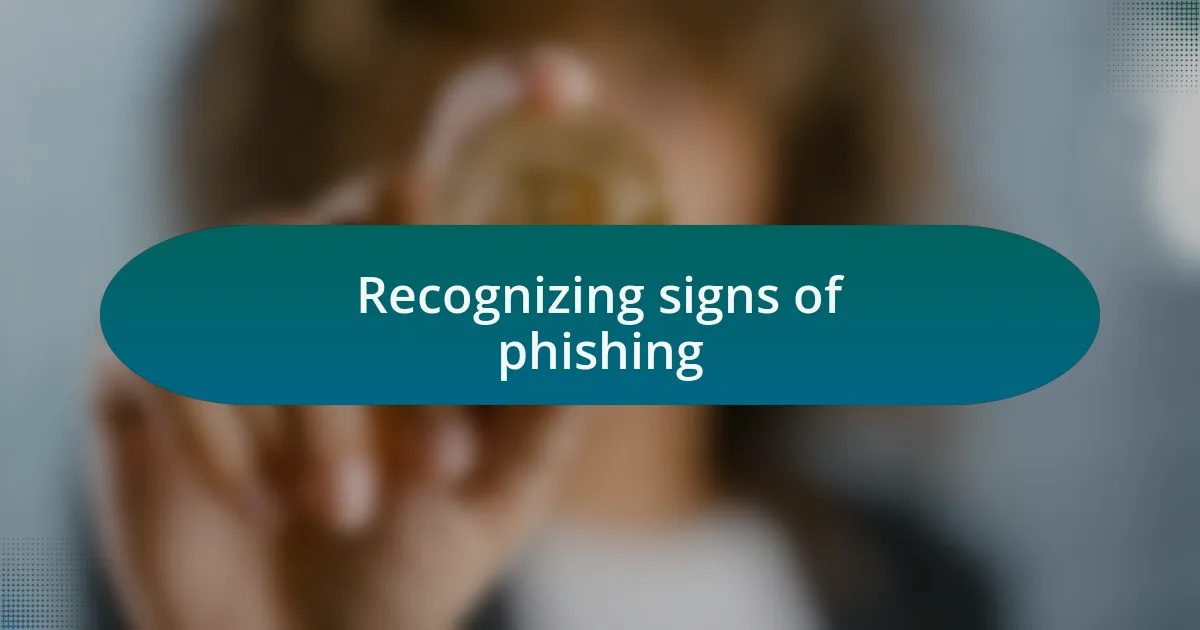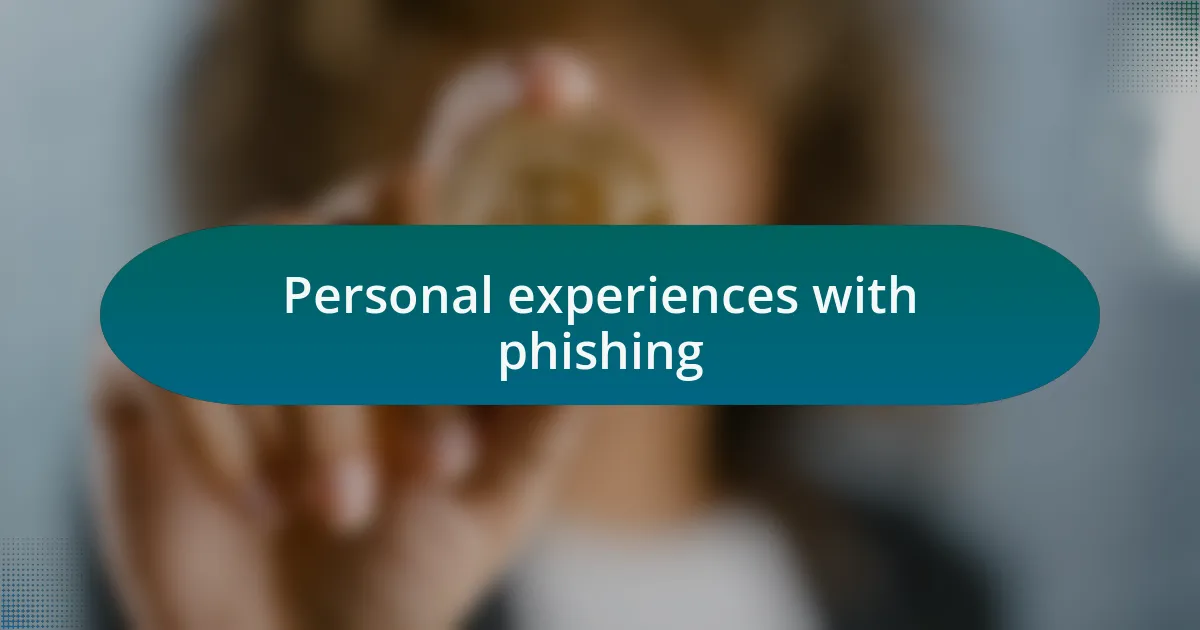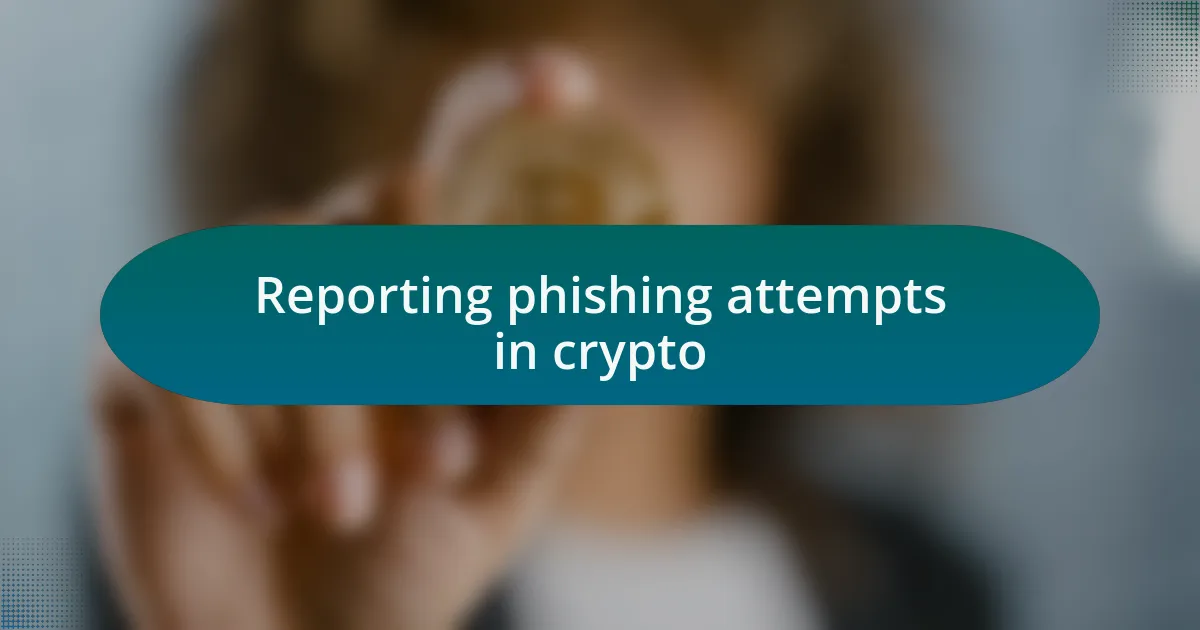Key takeaways:
- Phishing attacks use deceptive tactics like fake emails and websites to steal sensitive information or install malware, emphasizing the need for vigilance and verification.
- In cryptocurrency, robust security measures are crucial, as breaches can lead to significant financial losses and emotional distress for victims.
- Common phishing tactics include urgencies in communication, fake services, and social engineering, making it essential to trust instincts and verify sources.
- To protect against phishing, always verify communications, use two-factor authentication, and maintain strong, regularly updated passwords.

Understanding phishing attacks
Phishing attacks are deceptive attempts to steal sensitive information by masquerading as trustworthy entities, often through emails or fake websites. I remember the first time I nearly fell for such a tactic when I received an email that looked remarkably like a legitimate one from a well-known financial institution. The unsettling rush of realizing it was a scam made me acutely aware of the critical need to remain vigilant and discerning.
Have you ever received an email urging you to update your password with a link? That’s a classic phishing tactic designed to create urgency and pressure. It can be surprisingly effective because, emotionally, it triggers both fear and the instinct to protect one’s accounts. Each time I see such emails, they remind me how easily one can get caught off-guard in an attempt to safeguard something valuable, which is all the more reason to pause and verify.
Phishing isn’t always about acquiring passwords; sometimes the goal is to install malware that can compromise your devices. I recall a friend who suffered this fate after clicking a link in a seemingly harmless message. It not only cost him in terms of lost information but also in the stress and frustration of cleaning up the mess. Isn’t it fascinating—and frightening—how simple clicks can lead to such significant consequences? Understanding these attacks is key to being proactive rather than reactive.

Importance of security in crypto
Security is paramount in the crypto world, where the stakes are incredibly high. I once read about a crypto exchange that was hacked, resulting in millions lost to careless security practices. This incident hit home for me; it emphasized how crucial it is for platforms to implement robust security measures. After all, every crypto user deserves to have their assets protected.
The emotional toll of a security breach can be immense. I remember talking to a fellow trader who lost a significant portion of his savings due to a lack of two-factor authentication on his account. The anguish in his voice as he recounted the experience was a stark reminder of the personal impact of these attacks. It’s easy to overlook the significance of security features, but they can often be the difference between peace of mind and sheer panic.
In the rapidly evolving landscape of cryptocurrency, the importance of security cannot be overstated. Every time I explore new platforms, I now make a habit of digging into their security protocols before committing any funds. Have you thought about how your own practices might need to change to keep your investments safe? It’s essential to stay informed and proactive, or else we risk losing more than just digital currency—it’s our financial well-being at stake.

Common phishing tactics in crypto
Phishing attacks in the crypto space often take on deceptive forms. One common tactic I’ve seen involves fake websites that look remarkably similar to legitimate exchanges. I remember almost clicking on one during a late-night trading session; it felt so convincing at first glance. This experience made me realize how vital it is to double-check URLs and verify website authenticity.
Another prevalent tactic is the use of unsolicited emails claiming to be from crypto services. These emails usually contain urgent messages urging users to act quickly—often with offers too good to be true. Have you ever received one? I once received an email promising a complimentary bonus for verifying my account; it felt enticing at first, but a gut feeling told me to pause. That instinct probably saved me from giving away my private information.
Social engineering is also a common strategy, where attackers build a rapport with victims to manipulate them into revealing sensitive data. I encountered a fellow trader who shared how he trusted a “support representative” during a chat, only to find himself locked out of his account later. It’s crucial to remember that genuine support won’t ask for personal information like passwords or private keys. Trusting your instincts can be the first line of defense against such tactics.

Recognizing signs of phishing
Recognizing signs of phishing can sometimes be challenging, as attackers often employ elaborate strategies to deceive their targets. I remember browsing through my email and spotting a message that mimicked a notification from my crypto wallet provider. At first, I felt a wave of relief, but then I noticed the strange grammar and odd email address, which led me to question its authenticity. That moment illustrated how our instinct can often detect dishonesty even when the visuals appear trustworthy.
One striking sign of phishing is a sense of urgency in communications. I’ve received messages that were filled with alarming warnings, demanding immediate action to secure my account. These often made my heart race and triggered my fear of missing out on potential gains. In hindsight, panic should raise red flags. Legitimate companies usually don’t pressure their users— they provide clear, calm, and professional communication.
Another telltale sign is if the website lacks secure page indicators, such as HTTPS in the URL. I recall a time when I entered sensitive information on a site that didn’t have that reassuring little padlock icon. The moment I realized my mistake felt like a punch to the gut, emphasizing how vital it is to look for these indicators before unveiling any personal details. Ask yourself: Is this the level of security I would expect from a trusted platform? If you hesitate, it’s usually best to step back and reassess.

Personal experiences with phishing
I vividly remember a time when I received a direct message on social media that claimed to be from a well-known crypto exchange. The sender urged me to verify my account to avoid suspension, and the message felt almost personal. For a brief moment, I panicked, gripping my phone tightly as I contemplated the potential consequences. It’s a sobering reminder that even a credible platform can be misrepresented by malicious actors.
On another occasion, I stumbled upon a website while searching for trading strategies. The homepage was flashy, promising unbeatable returns, but something about it seemed off. As I clicked through, I felt a growing sense of unease—was I risking my funds? That hesitation was my saving grace, pushing me to dig deeper. I later discovered the site was a complete scam, designed to lure in unsuspecting traders like myself. Reflecting on it now, I wonder how many others might have fallen into that same trap without a second thought.
Another deep emotional experience occurred when a phishing email landed in my inbox, declaring that my account had been compromised. I rushed to follow the link provided without thinking twice, only to feel the cold sweat of fear wash over me as I realized I might have fallen for it. It was a gut-wrenching moment, realizing how easily fear can cloud judgment. I learned that trusting my instincts and taking a moment to verify before acting can be the difference between safety and disaster in the world of online trading.

Steps to protect against phishing
To protect against phishing, one of the first steps is to always verify the source of any communication. I recall a time when I received a seemingly urgent email about my account needing verification. Instead of clicking the provided link, I opted to visit the official website directly. That quick decision ensured I was safe because it turned out the email was fake. How often do we blindly trust messages that appear genuine?
Another effective measure is to activate two-factor authentication (2FA) whenever possible. I made the switch after a friend shared his harrowing experience of losing funds due to a phishing attack. His accounts were accessed simply because he didn’t have that second layer of security. Implementing 2FA made me feel more secure because even if my password were compromised, there was still a barrier in place. Doesn’t it make you wonder how many more safeguards we could implement for that extra peace of mind?
Regularly updating your passwords is critical, too. I’ve grown accustomed to using a password manager to generate complex passwords, making it harder for attackers to gain access. There was a time when I relied on easy-to-remember passwords, and I cringe thinking about how vulnerable I was. How many of us have fallen into that trap? Now, I can’t stress enough the importance of keeping that information fresh and unpredictable; it’s a small step that offers significant protection.

Reporting phishing attempts in crypto
When it comes to reporting phishing attempts in the crypto space, acting promptly is crucial. I remember opening a direct message on a trading forum that looked suspicious. Instead of ignoring it, I took the extra step to report it to the platform’s support team. It felt empowering to contribute to a safer community and reminded me that vigilance can help protect not just myself but others as well.
Many platforms have specific procedures for reporting phishing attempts, often detailing how to submit evidence such as screenshots or email headers. I once followed these steps after receiving a fraudulent message designed to look like legitimate correspondence from my exchange. The knowledge that I was helping the company track down scammers made the process feel worthwhile. Isn’t it gratifying to think that our small actions can play a role in enhancing security for everyone?
Additionally, I’ve found that sharing experiences with friends or within online communities can amplify awareness about phishing attempts. A friend of mine received a phishing email and posted about it in our group chat. Hearing his story not only alerted me to a new scam but also reinforced the idea that collective action makes a real difference. How often do we think about how sharing our experiences can educate and protect others?